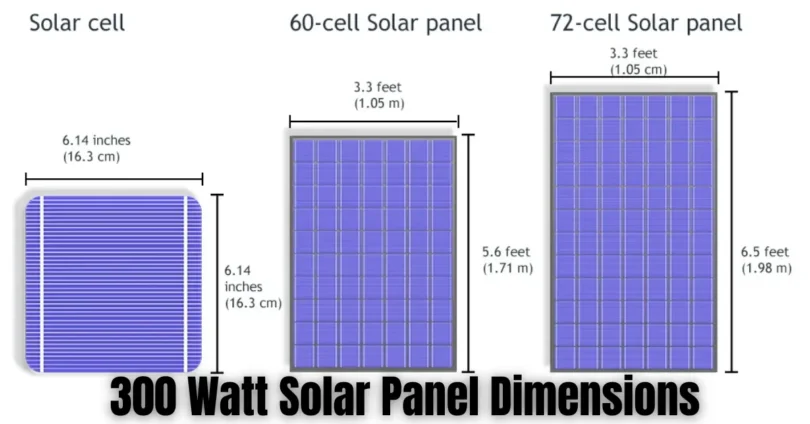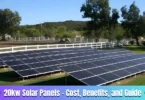When considering solar energy for your home or business, understanding the 300 watt solar panel dimensions is key to making the right choice. A 300 watt solar panel is a popular option due to its balance of efficiency and size. However, knowing its exact dimensions will help you plan your installation better and make sure it fits the space you have available.
In this article, we’ll dive into the typical size of a 300 watt solar panel, why it matters, and how to choose the best one for your needs.
What is a 300 Watt Solar Panel?
A 300 watt solar panel is a photovoltaic (PV) panel that generates 300 watts of power under optimal conditions. It’s commonly used in solar systems for residential and commercial energy needs.
General Uses of a 300 Watt Solar Panel:
- Residential Solar Systems: Perfect for homeowners who want to reduce energy bills and switch to clean energy.
- Commercial Applications: Used in larger solar setups for businesses looking to go solar.
- Off-Grid Systems: Ideal for off-grid living, providing enough power for basic appliances.
- Solar Farms: Frequently used in larger solar farms to generate bulk energy.
Why is 300 Watts a Popular Choice for Solar Panel Systems?
- Balanced Power Output: 300 watts provides a good amount of energy without being too large or too small.
- Efficiency: Offers a high efficiency-to-size ratio, making it a great option for limited space.
- Widely Available: 300 watt panels are commonly available, making them easier to purchase and install.
- Cost-Effective: A good balance of price and performance, offering value for money.
300 Watt Solar Panel Dimensions: Size and Specifications
Understanding the 300 watt solar panel dimensions is crucial for proper installation and energy planning. Here’s a breakdown of the typical size and weight of these panels.
Exact Dimensions (Length, Width, Height)
- Length: Around 65 inches (165 cm).
- Width: Typically 39 inches (99 cm).
- Height: Usually 1.5 to 2 inches (3.8 to 5 cm).
- These dimensions can vary slightly depending on the brand and model, but they are generally within this range for most 300-watt panels.
Average Weight of a 300-Watt Solar Panel
- Weight: Between 15 to 20 kg (33 to 44 pounds).
- The weight can depend on the type of material used (e.g., monocrystalline vs. polycrystalline) and the frame design.
Comparison with Other Wattage Sizes (250W, 400W)
- 250 Watt Panel: Slightly smaller and lighter, typically around 60 inches (152 cm) long and 37 inches (94 cm) wide.
- Ideal for smaller installations or limited roof space.
- 400 Watt Panel: Larger in size, usually about 78 inches (198 cm) long and 41 inches (104 cm) wide.
- Great for larger energy needs but requires more installation space.
Factors Influencing the Dimensions of a 300 Watt Solar Panel
The size and design of a 300 watt solar panel can vary depending on several key factors. Let’s explore what influences the dimensions of these panels.
Panel Efficiency and Technology
- Monocrystalline Panels: Typically more efficient, which means they produce more power in a smaller size.
- These panels are usually more compact compared to polycrystalline panels of the same wattage.
- Polycrystalline Panels: Slightly less efficient but often larger to make up for the difference in power output.
- They tend to take up more space for the same 300-watt power generation.
Material Choices (Frame, Glass, etc.)
- Frame Material: Aluminum frames are commonly used for durability but can add some weight and affect size slightly.
- Frames need to be strong enough to support the glass and solar cells, which can influence panel thickness.
- Glass Type: Tempered glass is used for durability and protection but adds weight and sometimes thickness.
- Thicker or stronger glass can slightly increase the panel’s overall size or weight.
Why Dimensions Matter: Understanding Panel Size
The dimensions of a 300 watt solar panel play a crucial role in both installation and energy output. Here’s why they matter:
Space Requirements for Installation
- Roof Space: The size of the panel affects how many you can fit on your roof.
- Larger panels (e.g., 400W) will require more space, while smaller ones (e.g., 250W) can fit in tighter areas.
- Installation Area: A 300-watt panel typically requires a moderate amount of space, making it suitable for most residential roofs.
- Proper planning ensures you can install enough panels to meet your energy needs without wasting space.
Impact on Energy Output (Efficiency vs. Space)
- Efficiency: A more efficient panel (e.g., monocrystalline) can produce the same amount of power in less space.
- This means you may need fewer panels to meet your energy goals, even if your space is limited.
- Power Generation: Bigger panels might generate more energy, but they need more roof space.
- If you have limited space, you may need to balance between panel size and the total amount of energy you need.
Real-Life Example: How 300 Watt Solar Panel Dimensions Fit Your Roof
Let’s take a look at how 300 watt solar panels fit on a typical residential roof and how to calculate how many panels you need for your energy goals.
Example Scenario of Installation on a Residential Roof
- Roof Size: A standard residential roof is about 1,500 to 2,000 square feet.
- With 300-watt panels measuring approximately 65 inches by 39 inches, they fit well on most average roofs.
- Panel Arrangement: Panels are usually arranged in rows and columns to maximize space.
- A 10×10-foot section of roof can comfortably hold around 4-6 panels, depending on space and layout.
How Many Panels Are Needed for Specific Energy Goals
- Average Household Energy Use: A typical U.S. home uses around 900 kWh per month.
- To meet this with 300-watt panels, you might need 24-30 panels, depending on your location and sunlight hours.
- Energy Output per Panel: Each 300-watt panel generates about 1.2-1.5 kWh per day under optimal conditions.
- Multiply this by the number of panels to calculate your total daily energy production.
Tips for Choosing the Right Size Based on Your Needs
When selecting 300 watt solar panels, it’s important to consider both your available space and energy requirements. Here are some helpful tips to guide you in making the right choice.
Considerations for Residential vs. Commercial Setups
- Residential Setups: Typically have limited roof space, so smaller panels or fewer panels may be needed.
- A 300-watt panel is usually sufficient for most households, with about 20-30 panels covering a typical home’s energy needs.
- Commercial Setups: Larger businesses or factories often have more roof space to work with.
- A higher number of 300-watt panels (or larger wattage panels) might be needed to meet the higher energy demand.
Matching Panel Size with Available Space and Energy Needs
- Space Limitations: If you have a smaller roof, consider the dimensions of each panel.
- 300-watt panels fit well on most residential roofs, but if space is tight, you may need to opt for higher-efficiency panels that produce more energy per square foot.
- Energy Goals: Calculate your daily or monthly energy use to determine how many panels you need.
- If your energy needs are modest, 6-8 panels might suffice. For larger homes or high-energy use, you might need 15-20 panels or more.
Common FAQs About 300 Watt Solar Panel Dimensions
What are the dimensions of a 300-watt solar panel?
A typical 300-watt solar panel is around 65 inches long, 39 inches wide, and about 1.5 to 2 inches thick. The exact size can vary slightly depending on the brand.
How much does a 300-watt solar panel weigh?
A 300-watt solar panel usually weighs between 15 to 20 kg (33 to 44 pounds).
Can a 300-watt solar panel fit on my roof?
Most residential roofs can easily accommodate 300-watt panels, but the number you can install depends on your roof size. For example, you may need about 24-30 panels for a typical home’s energy needs.
How much energy can a 300-watt solar panel produce?
A 300-watt solar panel can produce around 1.2 to 1.5 kWh of energy per day under ideal sunlight conditions.
How do 300-watt panels compare to other sizes?
A 300-watt panel offers a good balance between size and power output. Compared to smaller panels (e.g., 250W), it produces more energy, while larger panels (e.g., 400W) require more space but generate even more power.
Do 300-watt solar panels work for both homes and businesses?
Yes, 300-watt panels are versatile and can be used for both residential and commercial setups, depending on the number of panels you install to meet your energy needs.
How do I calculate how many panels I need?
To calculate the number of panels, first figure out your energy needs (in kWh). Then, divide your total energy requirement by the energy each 300-watt panel produces per day to determine how many panels you’ll need.
Conclusion
Understanding the 300 watt solar panel dimensions is key to choosing the right system for your needs. Whether you’re setting up for a small home or a larger commercial space, knowing the size of the panels, how many you need, and how they fit on your roof will help you make an informed decision.
By considering factors like available space, energy goals, and panel efficiency, you can easily select the best solar panel setup that works for you.




